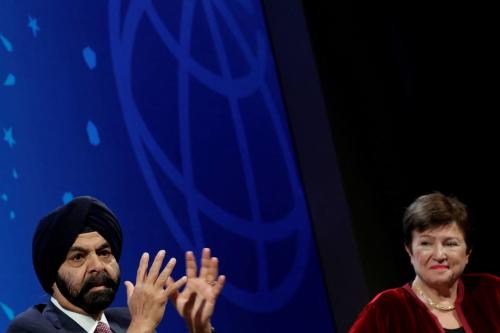As the global economy recovers, at the head of the pack with stronger than anticipated growth are the “emerging” countries in Asia. These countries have managed to withstand tough global economic conditions that nearly led to depression elsewhere, thanks to their resilient aggregate demand, sound policy fundamentals, and swift reaction to the crisis.
Much has changed since the Asian financial crisis in the late 1990s, which was characterized by sharp contractions in economic activity and even some social and political turmoil. While the IMF intervened at the time, its programs were later found to be too limited in scope, excessive in their conditionality, and inadequately designed to address immediate challenges.
This time around, the IMF has acted more forcefully, with institutional vigor that it previously never displayed. Specifically, it has established a new facility — the Flexible Credit Line — which provides countries with a sound track record potentially unlimited access to Fund resources. It has also upgraded its lending framework and has promised to better safeguard its members’ interests. The IMF has become the central international organization providing high-level advice to the G20 leadership. Through critical analysis and recommendations, the IMF has served as the foundation for collaborative official actions essential for containing the potentially devastating effects of the recent crisis.
While the IMF’s new-and-improved responsiveness has appealed to several countries, almost no Asian nation has called on it for assistance. Singapore and Korea have preferred to seek support from the U.S. Federal Reserve in the form of bilateral currency swaps. In fact, Korea has proposed a new global swap regime that would allow countries to reduce their reliance on exports and thus reduce the need for precautionary reserves as well.
For their part, East Asian nations have launched the Chiang Mai Initiative Multilateralization — a $120 billion regional currency swap agreement between Korea, China, Japan and the 10 ASEAN members — which will establish an operational surveillance unit in Singapore by the spring of 2011. In other words, they have created an embryonic Asian Monetary Fund. The fact that the IMF is not more preeminent in Asia is symptomatic of regional preferences to pursue structural reforms of the international monetary system rather than incremental changes at the IMF’s institutional level.
Increasing financial openness in Asia has brought considerable advantages in terms of additional funding opportunities for local companies. But it has also created new sources of vulnerabilities due to the pro-cyclical nature of international capital flows and contagion from financial crises experienced in other, often neighboring, economies. Korea and other Asian countries experienced this firsthand in the late 1990s and since then have embarked on the large-scale accumulation of foreign reserve assets to use as a buffer against sudden stops in international capital flows. Yet, because such reserve assets are mainly denominated in U.S. dollars, euro or other national currencies, their external value is exposed to unilateral policy adjustments that the respective issuing countries may want or need to make. This risk would be considerably reduced if countries could hold larger quantities of Special Drawing Rights as foreign reserves. As “synthetic” reserve assets consisting of a basket of major world currencies, they are typically less volatile than any given reserve currency issued by a particular country or area.
Any attempt to strengthen the role of SDRs in the international monetary system should first reinforce the link between SDRs and their issuing institution, the IMF, which, by virtue of its global regulatory role, should control the provision of SDRs based on global liquidity needs. Although theoretically this appeals to many analysts, it is not currently politically feasible since it presupposes stronger global governance. At the moment, any decisions on the issuance of SDRs, including the recent allocations endorsed by the G20, are in the hands of member countries. Since some of them are reserve-issuers, they do not feel the urgency in moving forward this agenda.
Another needed structural reform is the establishment of a multilateral forum for global surveillance where advanced and “emerging” economies could examine mutual economic policy spillovers on an equal or peer basis. This is where the most progress has been witnessed over the past couple years with the establishment of the G20 leader summits as the premier forum for international economic cooperation. The fact that the G20 has been elevated to this status undoubtedly reflects the desire of the U.S. and others to integrate the world’s most dynamic economies into a global framework.
The forthcoming G20 summits in Toronto in June and in Seoul in November will feature a major discussion on the coordinated policy responses needed to put the global economy on a path toward “strong, sustainable and balanced growth.” What is historically significant with these forthcoming discussions is that they include all the systemically-important economies of the world, many of which are in Asia. Indeed, the very fact that these summits will unfold under the Korean chairmanship of the G20 is emblematic in itself.
However, the emergence of the G20 as the global surveillance forum competes directly with the IMF’s role as a forum for international monetary cooperation, which is set forth in the IMF charter. This leads to another much-needed structural reform in IMF governance. If the Fund hopes to boost its role in the international monetary system, it must modernize its governance and fill the void created by the current asymmetry between the role that rapidly-growing countries have in the world economy and the weight they are given in IMF decision-making, which still favors Europe and North America.
Since many Asian countries are underrepresented at the IMF and feel little ownership in the institution, they hesitate to submit their economic policies to IMF scrutiny. Should they find themselves in need of international liquidity buffers to counter potential sudden shifts in global capital flows, the state of affairs at the IMF may incentivize these countries to directly approach the issuer of the main reserve assets, or the U.S. Federal Reserve.
IMF reforms that represent enhancements at the institutional level but do not also take into account needed structural reforms of the international monetary system will not truly enhance the Fund’s position in Asia or improve its level of engagement in the region. Such reforms should hopefully feature on the agenda of world leaders soon.



Commentary
Op-edIMF and Asia: What’s next after G20?
June 24, 2010